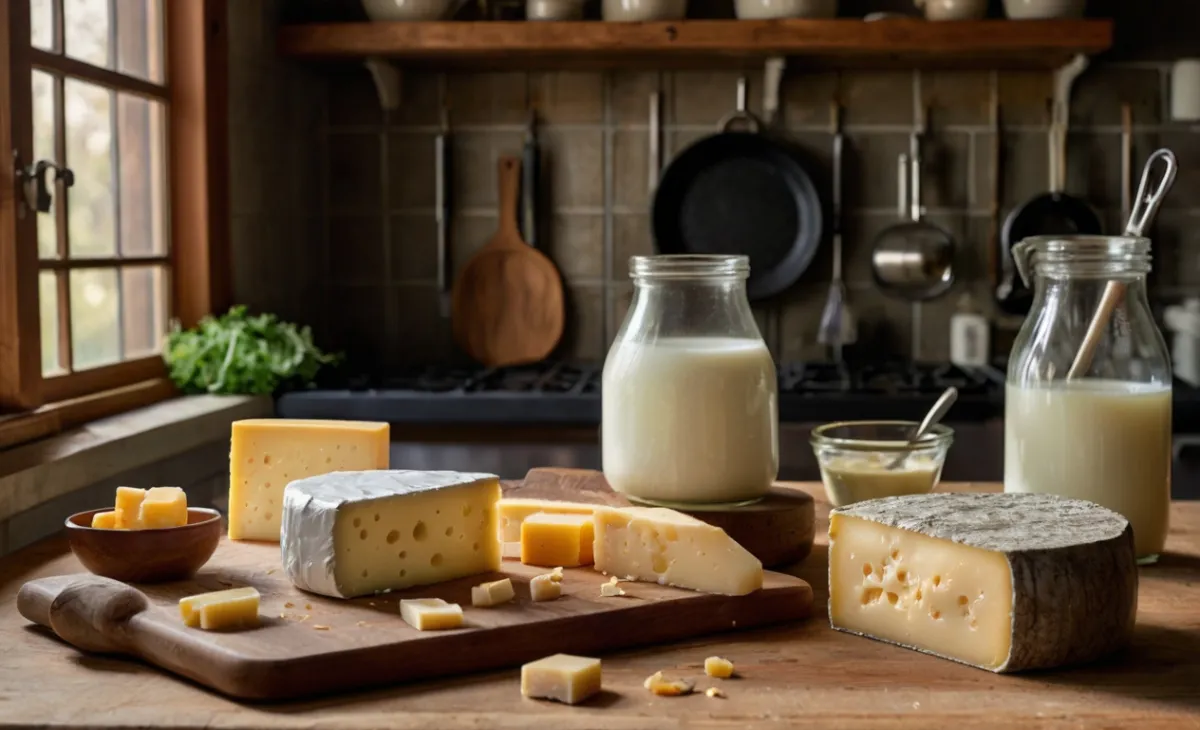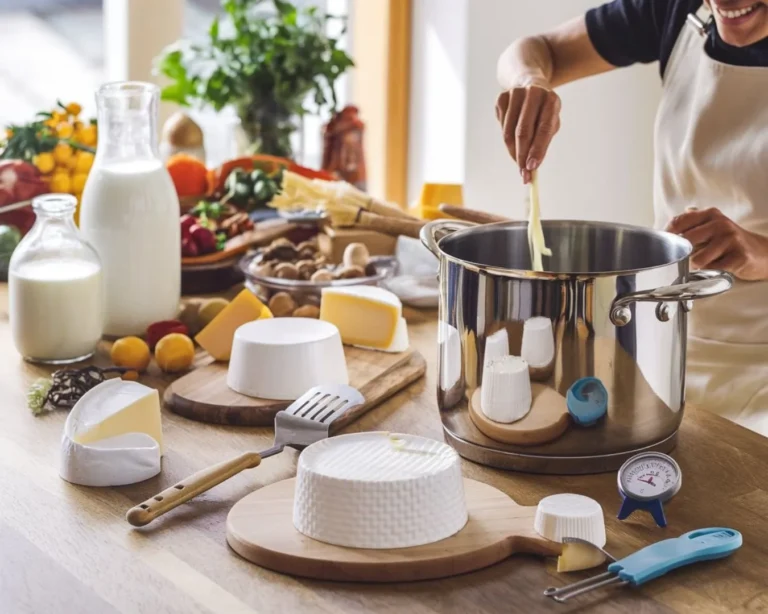How to Make Cheese Step by Step: Simple Recipes for Homemade Delights
How to Make Cheese Step by Step: Simple Recipes for Homemade Delights
Have you ever thought about making cheese in your own kitchen? If you’re like many people, the idea of crafting your own cheese might seem intimidating at first. But once you dive in, you’ll quickly realize that it’s not only possible, it’s incredibly rewarding. Whether you’re craving the creamy richness of homemade ricotta, the smoothness of mozzarella, or the tangy bite of fresh cream cheese, learning how to make cheese step by step opens the door to endless possibilities for your meals and snacks. Imagine enjoying a warm, gooey mozzarella made from scratch, or savoring the rich flavors of a fresh, homemade ricotta. This guide will walk you through the process, step by step, ensuring that you can make your own delicious cheeses with ease.
Understanding the Basics of Cheese Making
What is Cheese and How Does it Form?
Before you start making cheese, it’s important to understand the basics of the process. At its core, cheese is the result of transforming milk into a solid form through curdling. The curds are the solid bits of milk proteins and fats, and the whey is the liquid that remains after the curds have been separated. The key to making cheese is controlling the curdling process, which is achieved by adding ingredients like rennet (a natural enzyme) and cultures (bacteria that help develop flavor). The curds are then processed in various ways, depending on the type of cheese you’re making.
Milk is the foundation of cheese-making, and the type of milk you use can significantly affect the final product. Whole milk, preferably raw and unpasteurized, is the best option for making cheese as it retains its natural enzymes and bacteria. However, pasteurized milk can also be used if raw milk is not available. You’ll also need other ingredients like salt, rennet, and starter cultures, which introduce the necessary bacteria to develop the flavor of the cheese.
Essential Ingredients for Homemade Cheese
Making cheese at home requires only a few basic ingredients, but each one plays a vital role in the process. Here’s a breakdown of the essential ingredients you’ll need:
- Milk: The foundation of all cheese. Use whole milk for the best results, but you can experiment with goat’s milk or sheep’s milk for different flavors.
- Rennet: This is the enzyme responsible for curdling the milk, separating it into solid curds and liquid whey.
- Cultures: Bacteria cultures are added to the milk to aid in fermentation, giving your cheese its flavor and texture.
- Salt: Not only does it enhance the flavor, but it also helps preserve the cheese.
Most of these ingredients can be found at specialty food stores or online. Be sure to get high-quality, fresh ingredients for the best cheese-making experience.
Simple Cheese Recipes for Beginners
How to Make Fresh Ricotta Cheese
If you’re just starting out with cheese-making, ricotta is one of the easiest cheeses to make. It’s light, creamy, and requires very little equipment. The process takes just a couple of hours, and the results are well worth the effort.
Step-by-Step Instructions for Ricotta Cheese:
- Heat the Milk: Pour about 4 cups of whole milk into a large pot and heat over medium heat. Stir occasionally to prevent scorching.
- Add Acid: Once the milk reaches 190°F (88°C), add 2-3 tablespoons of lemon juice or vinegar. This will cause the milk to curdle.
- Let it Rest: After adding the acid, let the milk sit undisturbed for about 5 minutes. You should see curds form, separating from the whey.
- Strain the Curds: Place a fine mesh strainer or cheesecloth over a bowl and pour the curds and whey into it. Let the liquid drain off for 20-30 minutes, depending on how dry or wet you want your ricotta.
- Season and Enjoy: Once drained, transfer the ricotta to a bowl, add a pinch of salt, and mix it in. Your fresh ricotta is ready to use!
How to Make Homemade Mozzarella Cheese
Mozzarella is one of the most beloved cheeses, known for its smooth texture and melt-in-your-mouth creaminess. Making mozzarella at home may sound complicated, but once you break it down into steps, it’s surprisingly straightforward.
Step-by-Step Instructions for Mozzarella Cheese:
- Heat the Milk: Begin by heating 1 gallon of whole milk in a large pot to 85°F (29°C). Stir gently to avoid scorching.
- Add Citric Acid and Rennet: Dissolve 1 ½ teaspoons of citric acid in ¼ cup of water and add it to the milk. Then, dissolve ¼ teaspoon of rennet in ¼ cup of cool water and add it to the milk. Stir gently.
- Let the Milk Set: Cover the pot and let the milk sit undisturbed for 1 hour. During this time, the curds will form.
- Cut the Curds: After the curds have formed, cut them into 1-inch cubes using a knife. Let the curds sit for 5 minutes.
- Heat the Curds: Slowly heat the curds to 105°F (40°C), stirring gently to separate them.
- Stretch the Mozzarella: Once the curds reach the right temperature, take them out of the pot and begin stretching and folding them like taffy. This is where mozzarella gets its signature texture.
- Shape the Cheese: Once you’ve stretched the curd into a smooth, elastic texture, form it into balls or a loaf shape. Place the mozzarella in a bowl of ice water to firm up.
How to Make Cream Cheese at Home
Cream cheese is another simple cheese to make at home, perfect for spreading on bagels, making dips, or incorporating into desserts. You can make your own cream cheese with just a few ingredients, and it takes very little time to prepare.
Step-by-Step Instructions for Cream Cheese:
- Heat the Cream and Milk: In a pot, combine 1 cup of whole milk and 2 cups of heavy cream. Heat it to 180°F (82°C) while stirring occasionally.
- Add Culture: Add 1-2 tablespoons of starter culture and stir well. Cover the pot and let it sit for 12-24 hours at room temperature to allow the culture to ferment the mixture.
- Strain the Cheese: After the fermentation period, place a cheesecloth over a fine mesh strainer and pour the mixture into it. Let the excess liquid (whey) drain off for a few hours.
- Blend the Cheese: Transfer the drained cheese to a food processor and blend until smooth and creamy. Add salt to taste.

Step-by-Step Guide to Cheese-Making Equipment
Must-Have Tools for Cheese Making at Home
While you don’t need a lot of specialized equipment to make cheese at home, there are a few key tools that will make the process easier and more efficient. These include:
- Thermometer: An accurate thermometer is essential for monitoring milk temperatures during the cheese-making process.
- Cheesecloth: Used for straining curds and whey, a good-quality cheesecloth is an indispensable tool.
- Colander: A fine mesh colander helps separate the curds from the whey effectively.
- Cheese Mold: A cheese mold is used to shape the cheese as it sets.
- Cheese Press: For harder cheeses, a press is needed to squeeze out excess whey and compact the curds.
Optional Tools to Enhance Your Cheese-Making Experience
If you’re looking to get more advanced with your cheese-making, consider adding these optional tools to your kit:
- pH Meter: Monitoring the pH level of your cheese is especially important for more delicate cheeses.
- Cheese Cave or Aging Room: For aging cheeses like cheddar or gouda, you’ll need a cool, humid environment. A cheese cave or makeshift aging room can help you control these conditions.
Key Tips for Successful Cheese Making
How to Control Temperature and Humidity in Cheese Making
The temperature and humidity of your cheese-making environment can significantly affect the final product. It’s essential to keep a close eye on the temperature of the milk, as well as the environment in which your cheese is aging.
- Temperature: Different cheeses require different temperatures to form curds and develop flavor. Generally, fresh cheeses need to be kept at lower temperatures, while harder cheeses require warmer conditions.
- Humidity: As cheese ages, humidity levels are crucial for creating the right texture and preventing cracking.
How to Handle Whey and Curd Properly
Whey is the liquid that’s left behind when curds form, and while you might be tempted to throw it away, don’t. Whey is rich in nutrients and can be used in soups, smoothies, or for baking. Learning how to properly drain and manage whey is key to getting the texture you want in your cheese.
How to Age Your Cheese (Optional)
The Basics of Cheese Aging
Aging cheese, or affinage, is the process where cheese is left to mature over time to develop its flavor and texture. The type of cheese you’re making will determine whether or not it needs aging. Fresh cheeses like ricotta and mozzarella don’t require aging, but harder cheeses like cheddar or parmesan do.
How to Create a Cheese Aging Environment at Home
If you want to age your cheese, you’ll need to create the right environment. This typically requires cool temperatures (about 50°F or 10°C) and high humidity (80-90%). A dedicated cheese cave, a wine fridge, or even a cool, damp basement can serve as an aging space.
Troubleshooting Common Cheese-Making Problems
What to Do if Your Cheese Doesn’t Set Properly
If your cheese doesn’t set, it’s often due to the milk not being hot enough, the rennet being old, or the culture not being active. Always ensure you’re using fresh ingredients and following the steps carefully.
How to Prevent Your Cheese from Becoming Too Dry or Too Wet
One of the most common issues in cheese-making is ending up with cheese that’s too dry or too wet. If your cheese is too dry, it likely didn’t drain properly, or it was overcooked. If it’s too wet, it may need more draining or a longer aging process.
Conclusion: Unlock the Delicious World of Homemade Cheese
Making cheese at home is not only a fun and rewarding process, but it also allows you to enjoy fresh, flavorful cheese on your own terms. Whether you’re making a simple ricotta for a lasagna or stretching mozzarella for a pizza, each homemade cheese is a delicious reflection of your hard work and creativity. So why not give it a try? With the step-by-step instructions, helpful tips, and guidance provided here, you’re ready to start making your own cheeses at home. The world of homemade cheese is waiting for you—grab your ingredients and get started today!
FAQ
What is the easiest cheese to make at home?
Fresh cheeses like ricotta and cream cheese are the easiest to make at home because they don’t require aging and the process is quick and simple.
How long does it take to make cheese at home?
The time it takes to make cheese depends on the type of cheese. Fresh cheeses like ricotta can be made in just a couple of hours, while aged cheeses like cheddar take weeks or months to develop.
Can I make cheese without special equipment?
Yes, you can make cheese with basic kitchen tools. A thermometer, colander, and cheesecloth are all you need to get started. Optional tools like a cheese press can help, but they are not necessary for beginners.
How do I know when my cheese is ready to eat?
Fresh cheeses are ready to eat as soon as they’re made, while aged cheeses take longer to develop flavor. You can sample your cheese as it matures to see how it changes in texture and taste.







